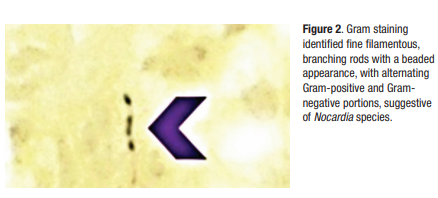Frank Winsett, MD, Caroline Crain, MD, Janice Wilson, MD, Kathleen Kroger, MD
CASE HISTORY

An 82-year-old man who was admitted for newly diagnosed pancytopenia secondary to myelodysplastic syndrome (MDS) presented to the dermatology consult service with a persistent growth on the lateral aspect of the right elbow. He reported bumping his elbow on a piece of furniture during a fall in his home two months prior; this resulted in a tear in the skin. Since then, the wound continued to bleed and eventually developed a 6-cm, erythematous, friable, fungating, and ulcerated mass on the right elbow without appreciable lymphadenopathy (Figure 1). There was neither associated pain nor pruritus. At this juncture, the patient had not yet begun therapy for MDS.
The patient did have other health issues, including hypertension, Type 2 diabetes, coronary artery disease, congestive heart failure, aortic stenosis, and prostate cancer (in remission). He was taking the following medications: glipizide, metformin, pravastatin, tamsulosin, gabapentin, venlafaxine, loratadine, ferrous gluconate, melatonin, and nitroglycerin.
Over the course of his evaluation, diagnostic work-up was largely unremarkable except for expected laboratory abnormalities. Of particular note, a chest x-ray and chest CT scan were normal. A biopsy was taken. The differential diagnosis was rather broad.
What do you think he has?
DISCUSSION
Skin biopsy revealed marked pseudoepitheliomatous hyperplasia with abundant underlying suppurative granulomatous inflammation. Numerous infectious stains were performed. Fite stain revealed rare fragments of branching rod-like structures. Gram staining further identified fine filamentous, branching rods with a beaded appearance, with alternating Gram-positive and Gram-negative portions, suggestive of Nocardia species (Figure 2). Acid-fast bacilli (AFB) culture grew Gram-positive branching bacilli later confirmed to be Nocardia vulneris (subtype of Nocardia brasiliensis with 99.37% homology of 16S rRNA gene sequence). Susceptibility testing revealed resistance to ceftriaxone, ciprofloxacin, clarithromycin, and imipenem; intermediate susceptibility to doxycycline, minocycline, and moxifloxacin; and susceptibility to amikacin, amoxicillin-clavulanate, linezolid, tobramycin, and trimethoprim/sulfamethoxazole.

Nocardia is typically found in soil and decaying vegetation and causes a wide range of clinical manifestations, including localized and disseminated disease.
The patient was initially started on trimethoprim-sulfamethoxazole and minocycline, but once susceptibility testing returned, he was transitioned to the least toxic drug, namely amoxicillin-clavulanate 875mg/125mg, twice daily. The patient responded well to therapy with significant clinical improvement after 4 months of treatment (Figure 3). The intended duration of treatment was at least 6 months. However, he continued to decline due to other comorbidities and ultimately expired before the completion of therapy.

Nocardia species are Gram-positive, aerobic, filamentous, partially acid-fast bacteria that are ubiquitous in the environment. Nocardia is typically found in soil and decaying vegetation and causes a wide range of clinical manifestations, including localized and disseminated diseases. It can manifest clinically as cellulitis, pustules, pyoderma, subcutaneous abscesses, and ulcerations, frequently resembling the soft tissue infections caused by staphylococci and streptococci. Primary cutaneous disease has a more indolent course than other forms of nocardiosis, and often develops in immunocompetent hosts. While many Nocardia species have been implicated in cutaneous disease, Nocardia brasiliensis is most commonly associated with infection of the skin and soft tissues. It is usually acquired through traumatic inoculation, and the majority of cases in the United States occur in the southern or southwestern regions.
This case was presented at the Texas Dermatological Society Spring Virtual Meeting, May 1, 2021.
_____________________________________________________________________________________________________________________


